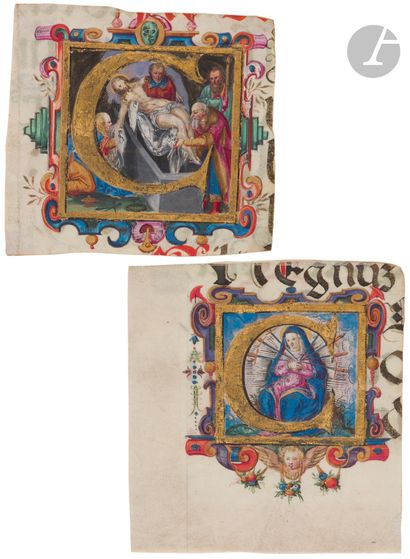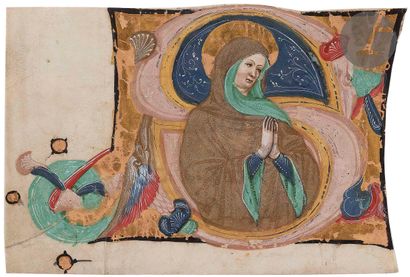Initiale « P » historiée. Vierge allaitant Fragment extrait d’un antiphonaire Tempera, gouache et or bruni sur parchemin Italie, Bologne, dernier quart du XIVe siècle Attribuable à Nicolò di Giacomo da Bologna Dimensions : H. 80 x L. 58 mm Texte : En latin, écriture gothique liturgique. Au verso, notation musicale carrée sur des portées de quatre lignes tracées en rouge, « […] are domi […] ». État : quelques tâches et petit trou au parchemin, initiale légèrement tronquée en sa partie inférieure ; au verso, encre pâle par endroit. Les numéros 14 et 15 proviennent du même manuscrit. Nicolò di Giacomo da Bologna (actif entre 1353 et 1401) est un enlumineur de Bologne et l’un des plus célèbres et prolifiques associés à la cité d’Émilie-Romagne. Il exerça à Bologne un quasi-monopole sur la production de manuscrits liturgiques mais travaille aussi pour des commanditaires municipaux (on lui doit plusieurs manuscrits de Statuts communaux). Il nous parait probable que les deux miniatures proposées ici proviennent du même manuscrit démembré et dont une initiale historiée représentant la « Naissance de saint Jean Baptiste » est conservée à Washington, National Gallery, dite « Rosenwald Nativity ». Feuillet connexe : Medieval and Renaissance Miniatures from the National Gallery of Art, Washington (1975), n°16 (Rosenwald Collection): “Initial F from a Choir Book (Antiphonary). Birth of John the Baptist. Provenance: E. Rosenthal, Berkeley; L.J. Rosenwald, Jenkintown (1949); This initial F, marking the Feast of the Birth of John the Baptist, was excised from an as yet untraced fourteenth-century Antiphonary. Its figure style, initial structure, color scheme, and border ornament are closely paralleled in a group of choir books in the Biblioteca Estense in Modena, all of which were once in the Monastery of San Michele in Bosco at Bologna. The decoration in those codices has been attributed through figure style and signature to Nicolò da Bologna. Among the eight choir books, the Rosenwald cutting is most clearly related to codex lat. 1023, and to codex lat. 1001…“ Ces deux manuscrits sont décrits par D. Fava et M. Solmi, I manoscritti miniati della Biblioteca Estense di Modena, Florence, 1950, nos. 6-11 ; 13-14. Bibliographie : Sur la carrière de Nicolò di Giacomo da Bologna dans les années 1370, voir F. Pasut, « Qualche considerazione sul percorso di Niccolo di Giacomo miniatore bolognese », in Arte Cristiana 86, pp. 431-444 ; voir aussi P. D’Ancona, « Nicolò da Bologna miniaturista del secolo XIV », in Arte lombarda 14, n°2 (1969). Voir aussi les notices consacrées à Nicolò di Giacomo da Bologna dans Palladino, Treasures of a Lost Art. Italian Manuscript Painting of the Middle Ages and Renaissance, The Metropolitan Museum of Art, Yale University Press, New Haven, and London, 2003, nos 10-14 ; M. Bollati, dans Miniature a Brera 1100-1422, n°32, pp. 210-211; G. Freuler, Italian miniatures : from the Twelfth to the Sixteenth centuries, 2013, n°24, pp. 284-293.
Initiale « P » historiée. Vierge allaitant Fragment extrait d’un antiphonaire Tempera, gouache et or bruni sur parchemin Italie, Bologne, dernier quart du XIVe siècle Attribuable à Nicolò di Giacomo da Bologna Dimensions : H. 80 x L. 58 mm Texte : En latin, écriture gothique liturgique. Au verso, notation musicale carrée sur des portées de quatre lignes tracées en rouge, « […] are domi […] ». État : quelques tâches et petit trou au parchemin, initiale légèrement tronquée en sa partie inférieure ; au verso, encre pâle par endroit. Les numéros 14 et 15 proviennent du même manuscrit. Nicolò di Giacomo da Bologna (actif entre 1353 et 1401) est un enlumineur de Bologne et l’un des plus célèbres et prolifiques associés à la cité d’Émilie-Romagne. Il exerça à Bologne un quasi-monopole sur la production de manuscrits liturgiques mais travaille aussi pour des commanditaires municipaux (on lui doit plusieurs manuscrits de Statuts communaux). Il nous parait probable que les deux miniatures proposées ici proviennent du même manuscrit démembré et dont une initiale historiée représentant la « Naissance de saint Jean Baptiste » est conservée à Washington, National Gallery, dite « Rosenwald Nativity ». Feuillet connexe : Medieval and Renaissance Miniatures from the National Gallery of Art, Washington (1975), n°16 (Rosenwald Collection): “Initial F from a Choir Book (Antiphonary). Birth of John the Baptist. Provenance: E. Rosenthal, Berkeley; L.J. Rosenwald, Jenkintown (1949); This initial F, marking the Feast of the Birth of John the Baptist, was excised from an as yet untraced fourteenth-century Antiphonary. Its figure style, initial structure, color scheme, and border ornament are closely paralleled in a group of choir books in the Biblioteca Estense in Modena, all of which were once in the Monastery of San Michele in Bosco at Bologna. The decoration in those codices has been attributed through figure style and signature to Nicolò da Bologna. Among the eight choir books, the Rosenwald cutting is most clearly related to codex lat. 1023, and to codex lat. 1001…“ Ces deux manuscrits sont décrits par D. Fava et M. Solmi, I manoscritti miniati della Biblioteca Estense di Modena, Florence, 1950, nos. 6-11 ; 13-14. Bibliographie : Sur la carrière de Nicolò di Giacomo da Bologna dans les années 1370, voir F. Pasut, « Qualche considerazione sul percorso di Niccolo di Giacomo miniatore bolognese », in Arte Cristiana 86, pp. 431-444 ; voir aussi P. D’Ancona, « Nicolò da Bologna miniaturista del secolo XIV », in Arte lombarda 14, n°2 (1969). Voir aussi les notices consacrées à Nicolò di Giacomo da Bologna dans Palladino, Treasures of a Lost Art. Italian Manuscript Painting of the Middle Ages and Renaissance, The Metropolitan Museum of Art, Yale University Press, New Haven, and London, 2003, nos 10-14 ; M. Bollati, dans Miniature a Brera 1100-1422, n°32, pp. 210-211; G. Freuler, Italian miniatures : from the Twelfth to the Sixteenth centuries, 2013, n°24, pp. 284-293.


.jpg)












Testen Sie LotSearch und seine Premium-Features 7 Tage - ohne Kosten!
Lassen Sie sich automatisch über neue Objekte in kommenden Auktionen benachrichtigen.
Suchauftrag anlegen